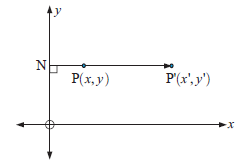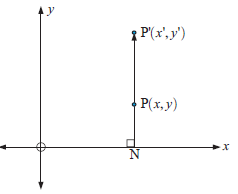HOW TO DO HORIZONTAL AND VERTICAL DILATION WITH THE GIVEN POINTS
Dilations are enlargements or reductions.
The transformation equation for a dilation with center (0, 0) and factor k are x' = kx and y' = ky
- If k > 1, the image figure is an enlargement of the object
- If 0 < k < 1, the image figure is an reduction of the object.
Vertical dilation with fixed y-axis :
Suppose P(x, y) moves P'(x', y') such that P' lies on the line through N(0, y) and P, and
we call this a horizontal dilation with the factor k.

For a horizontal dilation with factor k, the transformation equation are
x' = kx and y' = y
Vertical dilation with fixed x-axis :
Suppose P(x, y) moves P'(x', y') such that P' lies on the line through N(x, 0) and P, and
we call this a vertical dilation with the factor k.

For a vertical dilation with factor k, the transformation equation are
x' = x and y' = ky
Problem 1 :
Find the image of (2, 3) under a dilation with center O and factor 3.
Solution :
Here x = 2 and y = 3
dilation factor = 3, so k = 3
(x, y) ==> (kx, ky)
(2, 3) ==> ( 3(2), 3(3) )
(6, 9)
So, image of the point (2, 3) after the dilation is (6, 9).
Problem 2 :
Find the image of (-1, 4) under a dilation with center O and factor 1/3.
Solution :
Here x = -1 and y = 4
dilation factor = 1/3, so k = 1/3
(x, y) ==> (kx, ky)
(-1, 4) ==> ( 1/3(-1), 1/3(4) )
(-1/3, 4/3)
So, image of the point (-1, 4) after the dilation is (-1/3, 4/3).
Problem 3 :
Find the image of (3, -1) under a vertical dilation with factor 4
Solution :
Here x = 3 and y = -1
dilation factor = 4, so k = 4
(x, y) ==> (x, ky)
(3, -1) ==> (3, 4(-1))
(3, -4)
So, image of the point (3, -1) after the vertical dilation is (3, -4).
Problem 4 :
Find the image of (4, 5) under a vertical dilation with factor 2
Solution :
Here x = 4 and y = 5
dilation factor = 2, so k = 2
(x, y) ==> (x, ky)
(4, 5) ==> (4, 2(5)
(4, 10)
So, image of the point (4, 5) after the vertical dilation is (4, 10).
Problem 5 :
Find the image of (-2, 1) under a horizontal dilation with factor 1/2
Solution :
Here x = -2 and y = 1
dilation factor = 1/2, so k = 1/2
(x, y) ==> (kx, y)
(-2, 1) ==> (-2(1/2), 1)
(-1, 1)
So, image of the point (-2, 1) after the vertical dilation is (-1, 1).
Problem 6 :
Find the image of (3, -4) under a horizontal dilation with factor 3/2
Solution :
Here x = 3 and y = -4
dilation factor = 3/2, so k = 3/2
(x, y) ==> (kx, y)
(3, -4) ==> ((3/2)(3), -4)
(9/2, -4)
So, image of the point (3, -4) after the vertical dilation is (9/2, -4).
Recent Articles
-
Finding Range of Values Inequality Problems
May 21, 24 08:51 PM
Finding Range of Values Inequality Problems -
Solving Two Step Inequality Word Problems
May 21, 24 08:51 AM
Solving Two Step Inequality Word Problems -
Exponential Function Context and Data Modeling
May 20, 24 10:45 PM
Exponential Function Context and Data Modeling